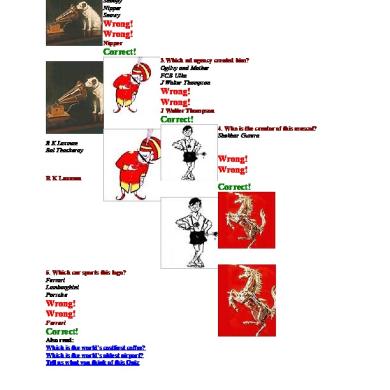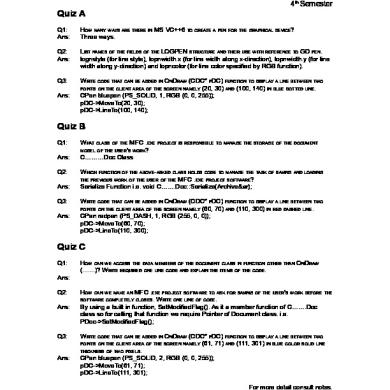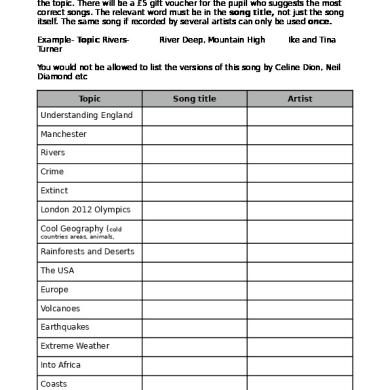Quiz 6&7.docx
This document was uploaded by user and they confirmed that they have the permission to share it. If you are author or own the copyright of this book, please report to us by using this DMCA report form. Report DMCA
Overview
Download & View Quiz 6&7.docx as PDF for free.
More details
- Words: 533
- Pages: 2
Quiz 6 & 7
3/25/19
1. All business expense deductions are claimed as "below the line" deductions. 2. Self-employed taxpayers can choose between claiming a deduction or a credit for the employer portion of self-employment taxes paid. 3. In general, taxpayers are allowed to deduct the fair market value of long-term capital gain property on the date of the donation to a qualified charitable organization. 4. The itemized deduction for taxes includes all types of state, local, and foreign taxes. 5. Taxpayers filing single and taxpayers filing married separate have the same basic standard deduction amount. 6. Generally, service businesses are considered qualified trade or businesses for purposes of the deduction for qualified business income. 7. Opal fell on the ice and injured her hip this winter. As a result she paid $3,070 for a visit to the hospital emergency room and $820 for follow-up visits with her doctor. While she recuperated, Opal paid $570 for prescription medicine and $670 to a therapist for rehabilitation. Insurance reimbursed Opal $1,270 for these expenses. What is the amount of Opal's qualifying medical expense? 8. Qualified dividends are always taxed at a 15 percent preferential rate. 9. Capital loss carryovers for individuals are carried forward indefinitely. 10. Two advantages of investing in capital assets are (1) gains are generally deferred and (2) gains are generally taxed at preferential rates. 11. Net investment income is always less than gross investment income. 12. Taxpayers may make an election to include preferentially-taxed capital gains and qualified dividends in investment income and deduct more investment interest expense currently if they are willing to subject this income to ordinary tax rates. 13. A passive activity is any activity that involves a trade or business or rental activity in which the taxpayer does not materially participate. 14. A loss from a passive activity is fully deductible as long as the taxpayer has sufficient tax basis in the activity. 15. Cory recently sold his qualified small business stock for $96,000 after holding it for ten years. His basis in the stock is $34,000. Applying the rules as if the stock were acquired in 2018 and assuming his marginal tax rate is 32 percent, how much tax will he owe on the sale?
Quiz 6 & 7
3/25/19
16. Brandon and Jane Forte file a joint tax return and decide to itemize their deductions. The Forte's income for the year consists of $119,100 in salary, $550 interest income, $1,050 nonqualifying dividends, and $550 long-term capital gains. The Forte's expenses for the year consist of $2,550 investment interest expense and $810 tax preparation fees. Assuming that the Forte's marginal tax rate is 30% and they make no special elections, what is the amount of investment interest expense deduction for the year? 17. Ms. Fresh bought 1,000 shares of Ibis Corporation stock for $6,800 on January 15, 2016. On December 31, 2018 she sold all 1,000 shares of her Ibis stock for $5,400. Based on a hot tip from her friend, she bought 1,000 shares of Ibis stock on January 23, 2019 for $3,450. What is Ms. Fresh's recognized loss on her 2018 sale and what is her basis in her 1,000 shares purchased in 2019?
3/25/19
1. All business expense deductions are claimed as "below the line" deductions. 2. Self-employed taxpayers can choose between claiming a deduction or a credit for the employer portion of self-employment taxes paid. 3. In general, taxpayers are allowed to deduct the fair market value of long-term capital gain property on the date of the donation to a qualified charitable organization. 4. The itemized deduction for taxes includes all types of state, local, and foreign taxes. 5. Taxpayers filing single and taxpayers filing married separate have the same basic standard deduction amount. 6. Generally, service businesses are considered qualified trade or businesses for purposes of the deduction for qualified business income. 7. Opal fell on the ice and injured her hip this winter. As a result she paid $3,070 for a visit to the hospital emergency room and $820 for follow-up visits with her doctor. While she recuperated, Opal paid $570 for prescription medicine and $670 to a therapist for rehabilitation. Insurance reimbursed Opal $1,270 for these expenses. What is the amount of Opal's qualifying medical expense? 8. Qualified dividends are always taxed at a 15 percent preferential rate. 9. Capital loss carryovers for individuals are carried forward indefinitely. 10. Two advantages of investing in capital assets are (1) gains are generally deferred and (2) gains are generally taxed at preferential rates. 11. Net investment income is always less than gross investment income. 12. Taxpayers may make an election to include preferentially-taxed capital gains and qualified dividends in investment income and deduct more investment interest expense currently if they are willing to subject this income to ordinary tax rates. 13. A passive activity is any activity that involves a trade or business or rental activity in which the taxpayer does not materially participate. 14. A loss from a passive activity is fully deductible as long as the taxpayer has sufficient tax basis in the activity. 15. Cory recently sold his qualified small business stock for $96,000 after holding it for ten years. His basis in the stock is $34,000. Applying the rules as if the stock were acquired in 2018 and assuming his marginal tax rate is 32 percent, how much tax will he owe on the sale?
Quiz 6 & 7
3/25/19
16. Brandon and Jane Forte file a joint tax return and decide to itemize their deductions. The Forte's income for the year consists of $119,100 in salary, $550 interest income, $1,050 nonqualifying dividends, and $550 long-term capital gains. The Forte's expenses for the year consist of $2,550 investment interest expense and $810 tax preparation fees. Assuming that the Forte's marginal tax rate is 30% and they make no special elections, what is the amount of investment interest expense deduction for the year? 17. Ms. Fresh bought 1,000 shares of Ibis Corporation stock for $6,800 on January 15, 2016. On December 31, 2018 she sold all 1,000 shares of her Ibis stock for $5,400. Based on a hot tip from her friend, she bought 1,000 shares of Ibis stock on January 23, 2019 for $3,450. What is Ms. Fresh's recognized loss on her 2018 sale and what is her basis in her 1,000 shares purchased in 2019?





